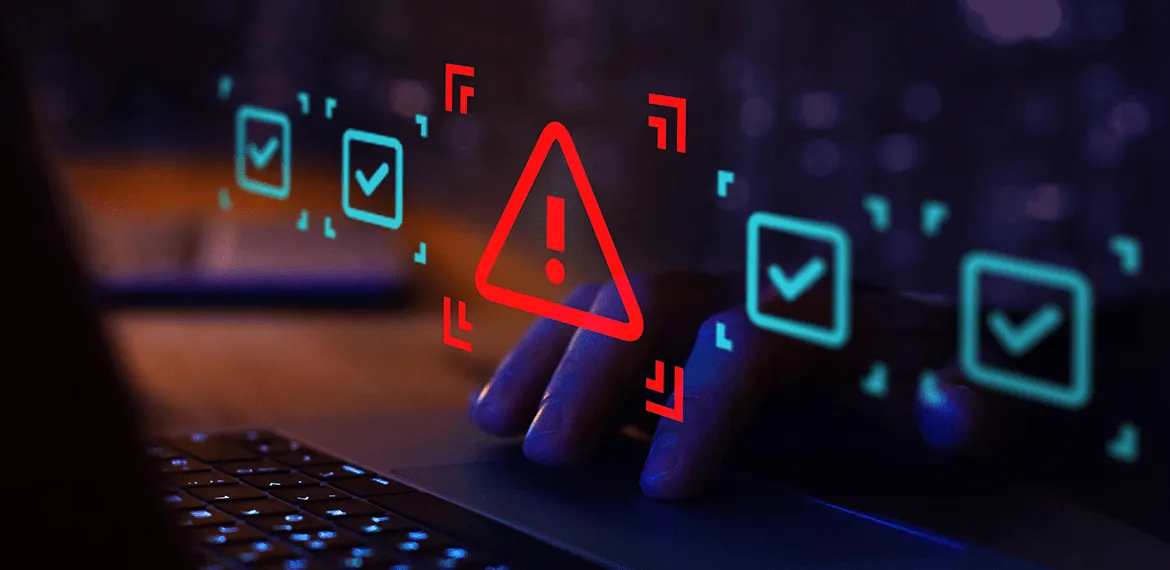
Using IT to Mitigate Insider Threats
How businesses can use IT to identify and prevent insider threats.
Insider threats are cybersecurity risks posed by people or companies with authorized access through accidental or intentional actions. While these issues originate from IT access, they can also be avoided with the right precautions in place. Learn more about the risks posed by insider threats and how IT policies and protections can shield your business.
What is an insider threat?
TechTarget defines an insider threat as a type of risk posed by end users who have approved access to a business or organization's physical or digital assets. Past and current employees are the usual perpetrators, but they're not the only ones. A company's vendors, contractors, and other business partners can also contribute to insider threats.
Insider threats are very common and cause a wide range of damage to the businesses they affect. According to the 2024 Insider Threat Report from Cybersecurity Insiders, 83% of organizations reported suffering from at least one insider attack. Recovery costs ranged from $100,000 to $499,000 for 32% of those businesses, and 21% spent $1 million to $2 million to recover. IBM’s analysis of the report highlights that the reported costs are the bare minimum because they don't include losses in reputation and consumer trust.
What are the different kinds of insider threats?
Cyber threats and attacks often involve multiple factors, and insider threats are no exception. Many varieties of insider threats stem from similar or related actions, which can also overlap with one another. According to IBM, insider threats usually fall under one of these three main categories.
1. Malicious insiders
A malicious insider is an individual who sabotages a business for revenge or personal gain. While disgruntled employees are the more common stereotype, those who commit corporate espionage fall in the same category. Competitors and other third parties can hire or convince people to disrupt a company's operations or share sensitive data.
For example, Tesla was impacted by a data breach in 2023 that originated from malicious insiders. Two former employees downloaded over 23,000 files that contained proprietary information and the personal details of over 75,000 personnel. They sent the data to a foreign newspaper, which alerted Tesla leadership of the leak instead of publishing the information.

2. Negligent insiders
A negligent insider is someone who creates vulnerabilities by failing to follow company protocols or cybersecurity best practices. Instead of acting with intent, these insiders contribute to threats because of ignorance or carelessness. These actions don't always lead to immediate cyberattacks, but they open the door for bad actors to gain access.
One hallmark example is Boeing's insider threat incident in 2017. An employee emailed a spreadsheet to his wife for formatting help, failing to realize that his coworkers' Social Security numbers and other personal information were stored in hidden columns. The email ended up exposing personal information for roughly 36,000 employees.
3. Compromised insiders
A compromised insider is a user whose credentials are stolen and manipulated by a hacker. These threats often take place because of some degree of negligence, whether it's by a single user or an entire company. Users can fall for a phishing or social engineering attack and fail to realize their access has been breached until it's too late.
The 2023 cyberattack on MGM Resorts International is a high-profile instance of a compromised insider threat that led to a major IT security failure. The attacker used social engineering to impersonate an employee and gain access to an account through the company's help desk. The company suffered an estimated $100 million in losses as a result.
Is one kind of insider more common than the other?
While malicious insiders are made to seem like the most common variety, negligent insiders are more dominant. The 2022 Ponemon Cost of Insider Threats Global Report found that 56% of insider threats were due to negligence and carelessness. Brian Schlechter, Director of IT at Bit-Wizards, reiterates that you're more likely to deal with negligent insiders.
“When people think of insider threats, they're more prone to think of a malicious individual who's out to ruin their employer and make money in the process,” he says. “Even if someone's acting maliciously, they're more likely a disgruntled person looking to get revenge than to make a profit, and malicious insiders are still vastly outnumbered by people who create insider threats by accident.”

What are the signs of an insider threat?
One of the best ways to reduce the risk of an insider threat is by knowing how to recognize one. According to NordVPN, certain behavioral and digital signs can suggest the presence or development of insider threats. Once you learn the signs, you can determine what your company's threshold is for sharing concerns with leadership or your IT department.
An individual involved with your business could potentially become an insider threat if they:
- Try to access information that isn't related to their role
- Have recurring conflicts with their managers or coworkers
- Refuse to follow company IT policies
- Express strong negative feelings about the organization
- Manage work tasks on their personal devices
Some of the technical signs of a potential insider threat can include:
- Significant spikes in network traffic
- Unexpected access requests
- Increased use of server resources
- Large file downloads
- Unusual or failed sign-in attempts
How should I respond to potential insider threats?
While recognizing the signs of an insider threat is essential, what matters even more is to determine an appropriate response. These signs are a suggestion, not a confirmation, and immediately taking a scorched-earth approach to wipe out a potential threat could do more harm than good. Schlechter says it's best to respond to issues with a productive approach.
“If you see a sign or get a tip from an employee, your response needs to be constructive and positive,” he explains. “You're most likely dealing with negligence or ignorance, so it's better to educate someone making a mistake instead of automatically treating them like they're intentionally committing corporate sabotage.”

How can I defend my business from insider threats?
Just like any other effective cybersecurity approach, the best way to avoid the consequences of insider threats is to do everything you can to prevent them from forming. While robust security measures should cover the majority of potential threats, you can take additional steps to mitigate the risks without compromising trust within your business. Here are four measures you can take to reduce insider threats.
1. Use least-privilege employee access
While granting unlimited access to your employees seems like a time-saver, it creates a considerable vulnerability if employees get into the wrong files, either intentionally or accidentally. Using a least-privilege approach means giving each employee the minimum access they need to do their jobs. Schlechter emphasizes that limiting access to what's needed can help avoid both malicious and negligent insiders.
“Using a least-privilege access policy limits the amount of damage anyone can do, which minimizes the blast radius of any purposeful or unintentional actions,” he says. “It generally helps keep everyone honest and safe from doing something wrong without affecting their ability to work.”
2. Monitor user and security alerts
You can't always keep an eye on every file that goes in and out of your business, but you can set up alerts to notify you of any unusual sign-ins, password changes, or other user activity. Using a data loss prevention (DLP) policy for your entire organization can especially help prevent sensitive information from being shared. With DLP rules in place, Schlechter says keeping an eye on potential threats is nearly effortless.
“For example, you can set a DLP policy rule where your company's finance or IT team gets an alert if an employee tries to email a credit card number to a coworker or client,” he explains. “That alert then needs approval from your finance or IT employees, so the extra layer of receiving an alert and approving a request helps prevent negligence from resulting in compromised access.”
3. Provide relevant cybersecurity training
Negligence is the most common type of insider threat across the board, and the best weapon against it is education. Your employees may not realize they're contributing to potential breaches, so conduct regular training to help them learn the dos and don'ts. In addition to cybersecurity fundamentals, Schlechter underlines that it's equally important to teach your team how to recognize and report potential risks.
“You can't just provide training on the basics—your employees need to learn how insider threats can originate from their own mistakes and how to identify other suspicious actions,” he says. “Whether their coworkers are being negligent or malicious, your team needs to know the signs and understand the importance of sharing their concerns with your company's leadership or IT team.”

4. Create an incident response plan
Insider threats and other cybersecurity concerns are not entirely avoidable, so it's critical to develop a plan for responding to compromised insider threats and other data breaches. Consider how your business will need to alert key personnel, contain the breach, conduct an investigation, and take other necessary steps. Schlechter mentions that these plans also need to account for various degrees of threat severity.
“While each plan should follow a similar process, you need to create different response levels based on who's involved and what's occurred,” he says. “You should even include different signs that indicate your IT team should limit someone's access to prevent a potential threat from becoming reality and impacting your business.”
Manage cyber threats and risks with Bit-Wizards
If you run a business with a handful of IT personnel, staying on top of internal and external threats while managing day-to-day operations is a tall order. With Managed IT Services (MITS) from Bit-Wizards, your business is shielded by a dedicated, proactive team. We take a multilayered security approach that uses enterprise-grade solutions to protect what matters most to your business.
In addition to providing help desk support and crafting custom solutions, our Wizards have experience with helping businesses overcome employee sabotage attempts and other insider threats. From managing user access permissions to monitoring security alerts, we have the breadth and depth of first-hand experience your company needs to stay protected in an ever-changing threat landscape.
Ready to empower your business with a proactive approach to IT security? Get in touch.